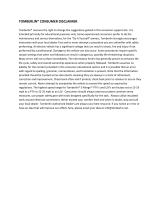
MADE IN U.S.A PAGE 4
PUBLICATION NO. 17228
PROCEDURE FOR REMOVAL OF A SHOE LEVER
(Refer to Fig. 1, Page 1)
1. If removal of the outer shoe lever “N” is
required, loosen locknut “U” and back off nut
“P” until the pull rod “A” may be lifted up
around the pivot in the outer armature “F”.
2. Refer to shoe retainer “M”. Both sides of the
shoe lever are equipped with a lock bracket,
screw, and retainer plate. Bend back tab of
the lock bracket. Remove screw and retainer
plate. When re-installing and after tightening
the screw, bend the tab of the lock bracket
against the flat of the screw.
3. With the retaining plate removed, slide the
outer shoe lever “N” to either side of the
brake.
4. To remove the inner shoe lever “L”, loosen
locknut “T” and turn screw “C” clockwise until
the pressure of the shoe against the wheel is
relieved. Refer to shoe retainer “M”. Both
sides of the shoe lever are equipped with a
lock bracket, screw, and retainer plate. Bend
back tab of the lock bracket. Remove screw
and retainer plate. When re-installing and
after tightening the screw, bend the tab of the
lock bracket against the flat of the screw.
5. With the retaining plate removed, slide the
outer shoe lever “L” to either side of the
brake.
REPLACEMENT OF A COIL
(Refer to Fig. 1, Page 1)
1. Turn torque adjuster “G” counter clockwise
until the torque spring is loose.
2. Disconnect thee pull rod end from the outer
armature “F”.
3. Remove screws “H” from base.
4. Lift the outer armature “F” out of the pocket
in the base and pull outward.
5. Remove the screws “J” used to attached the
coil to the base pedestal and slide coil from
base pedestal.
6. Set the new coil on the pedestal and install
mounting screws “J”. Do not tighten at this
time.
7. Set the armature “F” back into position. The
spring gland of the torque adjuster must be
centered in the hole of the inner armature
”D”. Assemble angle bracket and screws “H”
and “R” with screws hand tight only.
8. Attach pull rod “A” to armature “F”.
9. Pull armatures “F” and “D” together
magnetically or by using a clamp. Tighten
screws “H” and the base such that a
clearance of 0.25 ± 0.015 will be maintained
between the armature “F” and bracket “S”.
The clearance should be uniform. Remove
clamp (if used).
10. Adjust the torque spring and shoe positions
as described in the installation instructions.
PROCEDURE FOR RE-ADJUSTMENT FOR LINING WEAR
(Refer to Fig. 1, Page 1)
Periodic checks should be made on the
installation and when the sounding pins depress
more than 1/64” below surface, adjustments
should be made to compensate for normal lining
wear. This check and the adjustments should be
made when the wheel is at normal operating
temperature to allow for thermal expansion of the
wheel. Re-inspect after several operations.
1. Loosen the locknut “U” and tighten nut
“P” on the outer end of pull rod “A” until
the sounding pin in the outer armature
is flush with the surface when it is
pressed.
2. Loosen locknut “T”. Turn screw “C”
counter-clockwise to move the wedge
downward until the inner armature
sounding pin is flush when it is pressed
inward.
3. Tighten locknuts “U” and “T”.
It is recommended the brake shoe linings be
replaced when the lining thickness at the
center of the shoe has decreased to .125”
for riveted construction and .062 for bonded
construction. Use genuine OEM lining
material only to insure brake maintains
rated torque.
(See paragraph 14, Page 2)




 1
1
 2
2
 3
3
 4
4








